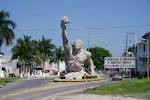Breaking the tide of the Gulf of Mexico, Campeche (Com pay CHAY) is one of the oldest colonial cities in Yucatán Peninsula, founded in 1540. In golden years, it thrived as the major port; trading timber, dyewood, silver and gold. An elegant city soon emerged behind the harbour, patterned with baroque style townhouses and ornamental plazas. Unfortunately, that news of prosperity swiftly traveled the far seas, capturing the attention of notorious seafarers. For years pirates plundered. Until eventually weary “Campechanos” built a fortress in the early 18th century. Today, only two segments of the once 2.5 km stone wall survive; the rest has been demolished and replaced with modernity.
Inside where the wall once stood, is one of Mexico’s most preserved colonial cities – added to the list of UNESCO World Heritage sites in 1999. In daylight, appealing pastel-colored houses are a portrait against the turquoise sky; while at night, shades dance between shadows and mellow light. Once an “Achilles’ heel,” Campeche’s sea location is now a strategic advantage. Its breezy streets a refreshing alternative to the swelter of inland Mérida, or Valladolid.
An interesting way to explore Campeche is to walk parallel to the remaining historic wall, near calle 8. Several bastions now house museums and galleries which showcase regional life and culture. In addition, the surrounding colonial architecture is impressive. “El Museo de la Ciudad,” the city museum, is in the bastion “Baluarte de San Carlos,” near the present state government building. From its roof, there is a decent view to the Gulf.
The principle plaza, boxed between calles 8 and 10, and 55 and 57, is the space to break between exploring. It’s breezy, especially after the hottest hours of the day. And Mexican plazas, you’ll observe, are awash with local life. There may even be a serenade. On the north side is a replica of the colonial administration headquarters. It’s an attractive building – mustard yellow, with arcaded terraces, stately decoration – which now houses a public library; and adjacent to that, “Centro Cultural Casa Número 6,” exhibits items from Campeche’s former high-society. The protagonist of the plaza, however, is the “Catedral de la Concepción Inmaculada,” Campeche’s incandescent cathedral. Its construction began shortly after the conquest, though was not complete until 1705.
To experience from above the wall, visit “Puerta de la Tierra,” the fortress gate at the end of calle 59. From its small stone stairway, you climb to the top and walk the stretch towards to “Baluarte de San Juan,” while overlooking Campeche’s urban sprawl. Inside the small rooms, a few artifacts attempt to convey the life and service of the militaries, though it’s not the most intriguing collection. It’s “Fuerte de San Miguel,” a colonial fort on the edge of the city, which shelters the superior museum. On display are several interesting pieces excavated from nearby archaeological zones, Calakmul and Edzná.
“Camerones al coco,” shrimp covered in coconut is the dish of Campeche, and you’ll find it almost everywhere. La Casa Vieja, overlooking the main plaza, is the restaurant with a view serving-up Yucatecan fare. Or to taste the unusual, grab a tamale – a traditional pre-Colombian corn dish steamed in a banana leaf – with a twist of chocolate from restaurant, Chocol Ha. In this trendy bistro, tucked inside a semi-restored home on calle 59, options range from traditional to European-inspired – all of course, with “cacao”.
Find accommodation in the historic center. Hotel Lopez on calle 12 (between 61 and 63) is a popular business hotel. Rooms are  comfortable and reasonably priced at around $500 MXP per night. While, on calle 59, Hacienda Puerta Campeche is upmarket. Its lavish rooms, around $500 USD a night, open onto a luscious courtyard, with an exquisite pool interweaving the colonnades. There’s also a spa, rooftop bar and fine restaurant. Otherwise, the Monkey Hostel on the main plaza is cheap, but has a priceless location.
comfortable and reasonably priced at around $500 MXP per night. While, on calle 59, Hacienda Puerta Campeche is upmarket. Its lavish rooms, around $500 USD a night, open onto a luscious courtyard, with an exquisite pool interweaving the colonnades. There’s also a spa, rooftop bar and fine restaurant. Otherwise, the Monkey Hostel on the main plaza is cheap, but has a priceless location.
Most people arrive into Campeche on the 180 highway from Mérida. If you head south, along the Gulf coast, you’ll connect to the states of Tabasco and Chiapas. A 2-3 day stay is sufficient within the city, though if you have more time, explore the archaeological sites Calakmul, Edzná and Becán further inland.
For more information, visit the tourism desk just off the main plaza, on calle 55.

